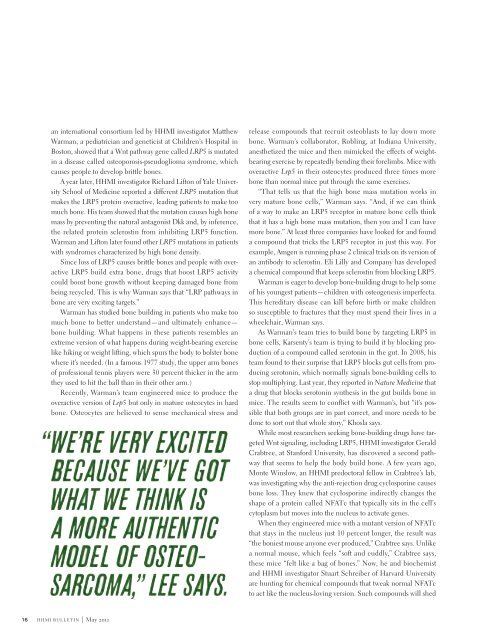Download PDF - Howard Hughes Medical Institute
Download PDF - Howard Hughes Medical Institute
Download PDF - Howard Hughes Medical Institute
Create successful ePaper yourself
Turn your PDF publications into a flip-book with our unique Google optimized e-Paper software.
an international consortium led by HHMI investigator Matthew<br />
Warman, a pediatrician and geneticist at Children’s Hospital in<br />
Boston, showed that a Wnt pathway gene called LRP5 is mutated<br />
in a disease called osteoporosis-pseudoglioma syndrome, which<br />
causes people to develop brittle bones.<br />
A year later, HHMI investigator Richard Lifton of Yale University<br />
School of Medicine reported a different LRP5 mutation that<br />
makes the LRP5 protein overactive, leading patients to make too<br />
much bone. His team showed that the mutation causes high bone<br />
mass by preventing the natural antagonist Dkk and, by inference,<br />
the related protein sclerostin from inhibiting LRP5 function.<br />
Warman and Lifton later found other LRP5 mutations in patients<br />
with syndromes characterized by high bone density.<br />
Since loss of LRP5 causes brittle bones and people with overactive<br />
LRP5 build extra bone, drugs that boost LRP5 activity<br />
could boost bone growth without keeping damaged bone from<br />
being recycled. This is why Warman says that “LRP pathways in<br />
bone are very exciting targets.”<br />
Warman has studied bone building in patients who make too<br />
much bone to better understand—and ultimately enhance—<br />
bone building. What happens in these patients resembles an<br />
extreme version of what happens during weight-bearing exercise<br />
like hiking or weight lifting, which spurs the body to bolster bone<br />
where it’s needed. (In a famous 1977 study, the upper arm bones<br />
of professional tennis players were 30 percent thicker in the arm<br />
they used to hit the ball than in their other arm.)<br />
Recently, Warman’s team engineered mice to produce the<br />
overactive version of Lrp5 but only in mature osteocytes in hard<br />
bone. Osteocytes are believed to sense mechanical stress and<br />
release compounds that recruit osteoblasts to lay down more<br />
bone. Warman’s collaborator, Robling, at Indiana University,<br />
anesthetized the mice and then mimicked the effects of weightbearing<br />
exercise by repeatedly bending their forelimbs. Mice with<br />
overactive Lrp5 in their osteocytes produced three times more<br />
bone than normal mice put through the same exercises.<br />
“That tells us that the high bone mass mutation works in<br />
very mature bone cells,” Warman says. “And, if we can think<br />
of a way to make an LRP5 receptor in mature bone cells think<br />
that it has a high bone mass mutation, then you and I can have<br />
more bone.” At least three companies have looked for and found<br />
a compound that tricks the LRP5 receptor in just this way. For<br />
example, Amgen is running phase 2 clinical trials on its version of<br />
an antibody to sclerostin. Eli Lilly and Company has developed<br />
a chemical compound that keeps sclerostin from blocking LRP5.<br />
Warman is eager to develop bone-building drugs to help some<br />
of his youngest patients—children with osteogenesis imperfecta.<br />
This hereditary disease can kill before birth or make children<br />
so susceptible to fractures that they must spend their lives in a<br />
wheelchair, Warman says.<br />
As Warman’s team tries to build bone by targeting LRP5 in<br />
bone cells, Karsenty’s team is trying to build it by blocking production<br />
of a compound called serotonin in the gut. In 2008, his<br />
team found to their surprise that LRP5 blocks gut cells from producing<br />
serotonin, which normally signals bone-building cells to<br />
stop multiplying. Last year, they reported in Nature Medicine that<br />
a drug that blocks serotonin synthesis in the gut builds bone in<br />
mice. The results seem to conflict with Warman’s, but “it’s possible<br />
that both groups are in part correct, and more needs to be<br />
done to sort out that whole story,” Khosla says.<br />
While most researchers seeking bone-building drugs have targeted<br />
Wnt signaling, including LRP5, HHMI investigator Gerald<br />
Crabtree, at Stanford University, has discovered a second pathway<br />
that seems to help the body build bone. A few years ago,<br />
Monte Winslow, an HHMI predoctoral fellow in Crabtree’s lab,<br />
was investigating why the anti-rejection drug cyclosporine causes<br />
bone loss. They knew that cyclosporine indirectly changes the<br />
shape of a protein called NFATc that typically sits in the cell’s<br />
cytoplasm but moves into the nucleus to activate genes.<br />
When they engineered mice with a mutant version of NFATc<br />
that stays in the nucleus just 10 percent longer, the result was<br />
“the boniest mouse anyone ever produced,” Crabtree says. Unlike<br />
a normal mouse, which feels “soft and cuddly,” Crabtree says,<br />
these mice “felt like a bag of bones.” Now, he and biochemist<br />
and HHMI investigator Stuart Schreiber of Harvard University<br />
are hunting for chemical compounds that tweak normal NFATc<br />
to act like the nucleus-loving version. Such compounds will shed<br />
16 h h m i b u l l e t i n | May 2o11
















